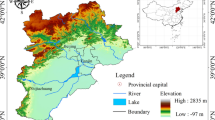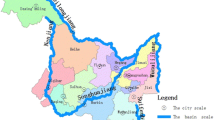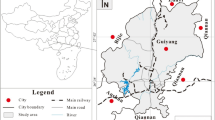Abstract
With the rapid economic development in the past decades, industrialization and urbanization in China has also rapidly developed and will continue in the next decades. However, the regional water shortage has posed great challenges for the sustainable development of big cities especially in north China. Here, we used the water ecological footprint model combined with the system dynamic model to assess the water resource carrying capacity and its sustainability in Zhangjiakou City, a typical water shortage city in north China. The calculated results showed that irrigation was the largest water consumer in Zhangjiakou. There existed a clear gap between water supply and water consumption in this city and such a gap is demonstrated by the high water resource pressure index. Our predicted results based on the water resource ecological footprint and the system dynamic model showed that although the improving water use efficiency has relieved the regional water shortage pressure, the efficiency gained would be to a large degree offset by increased water demands due to the increasing economic development. The annual average water shortage in Zhangjiakou in 2007–2050 would be up to 8.53 × 108 m3, nearly half of the total local average annual water resource. To deal with the severe water shortage over the next three decades, great attention should be paid to scientific water resource managements and water pollution control. This research provides a long-term view of water resource pressure and provides recommendations for a sustainable water use under the rapid regional socioeconomic development.









Similar content being viewed by others
Explore related subjects
Discover the latest articles and news from researchers in related subjects, suggested using machine learning.References
Allan JA (1998) Virtual water: a strategic resource global solutions to regional deficits. Groundwater 36:545–546
Chapagain AK, Hoekstra AY (2011) The blue, green and grey water footprint of rice from production and consumption perspectives. Ecol Econ 70:749–758
Chen ZM, Chen GQ (2013) Virtual water accounting for the globalized world economy: national water footprint and international virtual water trade. Ecol Indic 28:142–149
Chen H, Sun J (2015) Changes in drought characteristics over China using the standardized precipitation evapotranspiration index. J Clim 28:5430–5447
Chen D, Chen X, Kong L (2009) The calculations and analysis of regional ecological water resources carrying capacity cabased on ecological footprint analysis method. Ecol Environ Sci 18:2224–2229 (in Chinese)
Costanza R (1996) Economic growth, carrying capacity, and the environment. Environ Dev Econ 6:13–15
Dalin C, Qiu H, Hanasaki N, Mauzerall DL, Rodrigueziturbe I (2015) Balancing water resource conservation and food security in China. Proc Natl Acad Sci U S A 112:4588–4593
Dregne HE (1977) Desertification of arid lands. Econ Geogr 53:322–331
Gleick PH (2003) Global freshwater resources: soft-path solutions for the 21st century. Science 302:1524–1528
Guo L, Lin C, Liu D, Gao X (2008) Analysis on carrying capacity of water environment—taking Zhangjiakou City as an example. South North Water Transfers Water Sci Technol 6:105–108 (in Chinese)
Hester ET, Little JC (2013) Measuring environmental sustainability of water in watersheds. Environ Sci Technol 47:8083–8090
Hoekstra AY (2009) Human appropriation of natural capital: a comparison of ecological footprint and water footprint analysis. Ecol Econ 68:1963–1974
Hoekstra AY, Mekonnen MM (2012) The water footprint of humanity. Proc Natl Acad Sci 109:3232–3237
Huang LN, Zhang WX, Jiang CL, Fan XQ (2008) Ecological footprint method in water resources assessment. Acta Ecol Sin 28:1279–1286 (in Chinese)
Hubacek K, Guan D, Barrett J, Wiedmann T (2009) Environmental implications of urbanization and lifestyle change in China: ecological and water footprints. J Clean Prod 17:1241–1248
Jeswani HK, Azapagic A (2011) Water footprint: methodologies and a case study for assessing the impacts of water use. J Clean Prod 19:1288–1299
Jiang B, Wong CP, Lu F, Ouyang Z, Wang Y (2014) Drivers of drying on the Yongding River in Beijing. J Hydrol 519:69–79
Lei W, Wang ZJ, Koike T, Hang Y, Yang DW, Shan H (2010) The assessment of surface water resources for the semi-arid Yongding River Basin from 1956 to 2000 and the impact of land use change. Hydrol Process 24:1123–1132
Li Q, Zhou X, Chen Y, Yu S (2012) Water consumption characteristics of winter wheat grown using different planting patterns and deficit irrigation regime. Agric Water Manag 105:8–12
Liu J, Raven PH (2010) China’s environmental challenges and implications for the world. Crit Rev Environ Sci Technol 40:823–851
Ma Z, Kang S, Zhang L, Tong L, Su X (2008) Analysis of impacts of climate variability and human activity on streamflow for a river basin in arid region of Northwest China. J Hydrol 352:239–249
Pernet-Coudrier B, Qi W, Liu H, Müller B, Berg M (2012) Sources and pathways of nutrients in the semi-arid region of Beijing–Tianjin, China. Environ Sci Technol 46:5294–5301
Qin H-P, Su Q, Khu S-T (2011) An integrated model for water management in a rapidly urbanizing catchment. Environ Model Softw 26:1502–1514
Rees WE (1992) Ecological footprints and appropriated carrying capacity: what urban economics leaves out. Focus 6:121–130
Ress WE, Wackernagel M (1996) Ecological footprints and appropriated carrying capacity: measuring the natural capital requirements of the human economy. Focus 6:45-60
Seidl I, Tisdell CA (1999) Carrying capacity reconsidered: from Malthus’ population theory to cultural carrying capacity. Ecol Econ 31:395–408
Simonovic SP, Ahmad S (2004) Spatial system dynamics: new approach for simulation of water resources systems. J Comput Civ Eng 18:331–340
Song XM, Zhan CS (2011) Assessment of water resources carrying capacity in Tianjin City of China. Water Resour Manag 25:857–873
Sterman JD (2010) Learning in and about complex systems. Syst Dyn Rev 10:291–330
Stoeglehner G, Edwards P, Daniels P, Narodoslawsky M (2011) The water supply footprint (WSF): a strategic planning tool for sustainable regional and local water supplies. J Clean Prod 19:1677–1686
Tan X, Zheng Q (2009) Dynamic analysis and forescast of water resources ecological footprint in China. Acta Ecological Sinica 29:3559–3568 (in Chinese)
Veldkamp TIE, Wada Y, Aerts JCJH, Döll P, Gosling SN, Liu J, Masaki Y, Oki T, Ostberg S, Pokhrel Y (2017) Water scarcity hotspots travel downstream due to human interventions in the 20th and 21st century. Nat Commun 8:15697
Vörösmarty CJ, Mcintyre PB, Gessner MO, Dudgeon D, Prusevich A, Green P, Glidden S, Bunn SE, Sullivan CA, Liermann CR (2010) Global threats to human water security and river biodiversity. Nature 467:555–561
Wackernagel M (1999) An evaluation of the ecological footprint. Ecol Econ 31:317–318
Wackernagel, William (1998) Our ecological footprint: reducing human impact on the earth, vol 9. New Society Publishers, pp 2–20
Wackernagel M, Onisto L, Bello P, Linares AC, Falfán ISL, García JM, Guerrero AIS, Ma GSG (1999) National natural capital accounting with the ecological footprint concept. Ecol Econ 29:375–390
Wang W, Gong J, Qing P, Pan K, Hu Q (2011) Analysis of water resources ecological footprint and ecological carrying capacity in Chongqing City. Ecol Econ 7:159–162 (in Chinese)
Wang S, Yang FL, Xu L, Du J (2013) Multi-scale analysis of the water resources carrying capacity of the Liaohe Basin based on ecological footprints. J Clean Prod 53:158–166
Wang S, Xu L, Yang F, Wang H (2014) Assessment of water ecological carrying capacity under the two policies in Tieling City on the basis of the integrated system dynamics model. Sci Total Environ 472:1070–1081
Wang Y, Liu J, Zhao D (2018) Assessing water resources based on theory of water footprint- a case study in Xuanhua District, Zhangjiakou City, Hebei Province. Bull Soil Water Conserv 38:213–219 (in Chinese)
Winnie GL, Hoekstra AY, Meer TH, Van Der (2009) The water footprint of bioenergy. Proc Natl Acad Sci U S A 106:10219–10223
Winz I, Brierley G, Trowsdale S (2009) The use of system dynamics simulation in water resources management. Water Resour Manag 23:1301–1323
Xia J, Qiu B, Li Y (2012) Water resources vulnerability and adaptive management in the Huang, Huai and Hai river basins of China. Water Int 37:523–536
Yang J, Lei K, Khu S, Meng W (2015) Assessment of water resources carrying capacity for sustainable development based on a system dynamics model: a case study of Tieling City, China. Water Resour Manag 29:885–899
Yu C (2011) China’s water crisis needs more than words. Nature 470:307
Zhang Y, Chen M, Zhou W, Zhuang C, Ouyang Z (2010) Evaluating Beijing's human carrying capacity from the perspective of water resource constraints. J Environ Sci 22:1297–1304
Zhao X, Chen B, Yang ZF (2009) National water footprint in an input–output framework-a case study of China 2002. Ecol Model 220:245–253
Zhao X, Liu J, Liu Q, Tillotson MR, Guan D, Hubacek K (2015) Physical and virtual water transfers for regional water stress alleviation in China. Proc Natl Acad Sci U S A 112:1031–1035
Zhou XY, Lei K, Meng W, Khu ST, Jian Z, Wang M, Yang J (2017) Space–time approach to water environment carrying capacity calculation. J Clean Prod 149:302–312
Funding
This work was financially supported by the National Science and Technology Major Project-Water Pollution Control and Treatment (2018ZX07111002).
Author information
Authors and Affiliations
Corresponding author
Additional information
Responsible editor: Philippe Garrigues
Publisher’s note
Springer Nature remains neutral with regard to jurisdictional claims in published maps and institutional affiliations.
Rights and permissions
About this article
Cite this article
Dai, D., Sun, M., Xu, X. et al. Assessment of the water resource carrying capacity based on the ecological footprint: a case study in Zhangjiakou City, North China. Environ Sci Pollut Res 26, 11000–11011 (2019). https://doi.org/10.1007/s11356-019-04414-9
Received:
Accepted:
Published:
Issue Date:
DOI: https://doi.org/10.1007/s11356-019-04414-9




